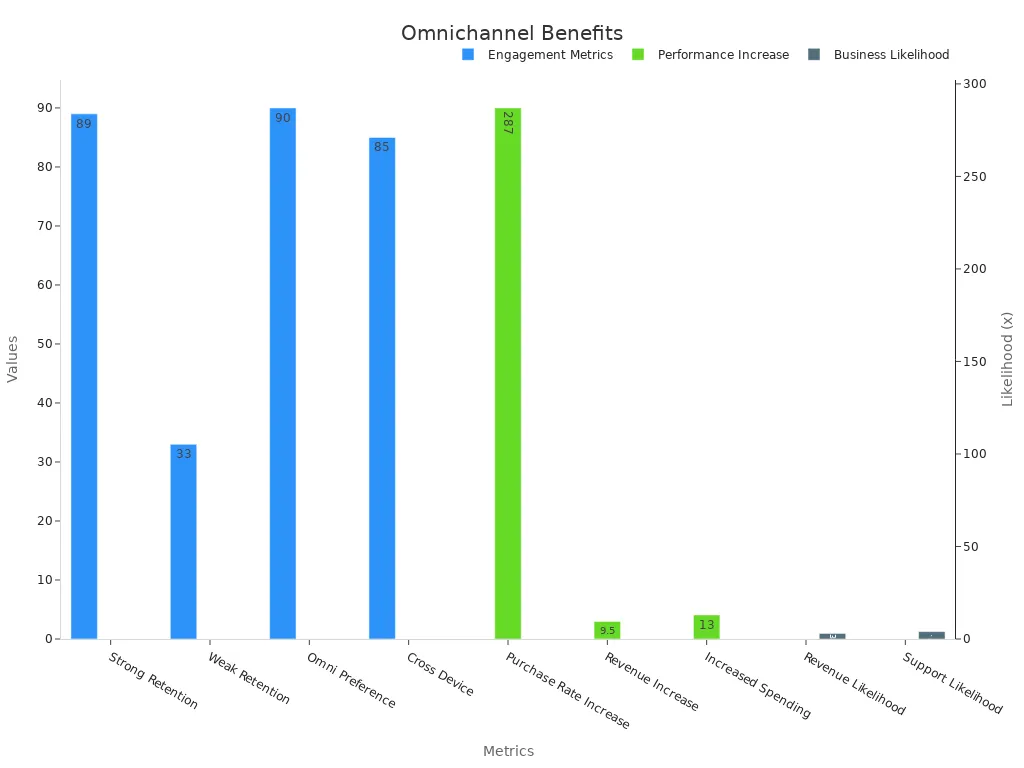How to Boost Employee Satisfaction with Omnichannel Communication

Imagine a workplace where communication flows effortlessly, and every employee feels connected and informed. That’s the power of omnichannel communication. It brings all communication channels together, creating a unified experience that eliminates confusion and boosts satisfaction. Studies show that 74% of employees feel they miss out on company updates, and 86% cite poor communication as the root of workplace failures. By fostering seamless collaboration, you can improve productivity by up to 25%.
Sobot’s solutions make this transformation possible. With tools like its Voice Call Center and omnichannel platform, you can unify communication, enabling your team to stay connected, whether they’re in the office or working remotely.
What Is Omnichannel Communication?
Definition and Key Features
Omnichannel communication is all about creating a seamless connection between different communication channels. It integrates both online and offline platforms, ensuring that every interaction feels consistent and unified. Whether it’s email, SMS, live chat, or social media, the system adapts to your needs, making communication smooth and efficient.
Unlike multichannel communication, which simply offers multiple options, omnichannel communication focuses on delivering a unified experience. This means no matter where or how you communicate, the message stays consistent. Digital technology plays a huge role here, enabling businesses to connect these channels and provide a cohesive experience.
Why Omnichannel Communication Matters for Internal Teams
An omnichannel approach to internal communications is essential for driving engagement and reaching employees where they are. It ensures that communication is personalized and relevant, addressing the needs and preferences of employees across various channels.
For internal teams, this approach eliminates confusion and ensures everyone stays on the same page. Imagine being able to access updates, messages, and resources from one platform, no matter where you are. It’s a game-changer for keeping your team informed and engaged.
Benefits for Employee Experience and Engagement
Omnichannel communication directly impacts the employee experience by making communication more accessible and efficient. When employees can easily find the information they need, they feel more connected and valued. This boosts engagement and helps create a positive work environment.
Additionally, a unified communication system reduces frustration caused by missed updates or scattered information. It fosters collaboration and ensures that every team member feels included, whether they’re working in the office or remotely.
How Omnichannel Communication Enhances Employee Satisfaction

Breaking Down Communication Silos
Communication silos can make employees feel disconnected and frustrated. When teams work in isolation, collaboration suffers, and important information gets lost. Omnichannel communication solves this problem by creating a unified platform where everyone can share updates, ideas, and feedback effortlessly.
Imagine a workplace where departments no longer struggle to communicate. With omnichannel communication, you can foster cross-team conversations and ensure that information flows freely. Tailored communication channels make it easier for employees to collaborate, whether they’re brainstorming ideas or solving problems.
Here’s how companies have successfully broken down silos:
- Ritter Communications introduced the PULSE program, which improved workflows and received 100% positive feedback from employees.
- Dawn Wood emphasizes the importance of upskilling to enhance communication across departments.
- Wendy Makinson recommends social events and conversation groups to strengthen interpersonal relationships.
By eliminating barriers, you create an environment where employees feel heard and valued. This boosts satisfaction and encourages teamwork.
Supporting Remote and Hybrid Work Models
Remote and hybrid work models are here to stay. But keeping employees connected in these setups can be challenging. Omnichannel communication bridges the gap by providing tools that support seamless interaction, no matter where your team is located.

For remote workers, having access to a unified communication system means they can stay informed without feeling isolated. Features like Sobot’s Voice Call Center allow employees to collaborate in real-time, whether through voice calls or instant messaging. This ensures that everyone feels part of the team, even when working from different locations.
Companies with effective internal communication strategies report impressive results:
| Metric | Impact |
|---|---|
| Increase in sales | 29% |
| Higher customer satisfaction | 35% |
When you prioritize communication for remote and hybrid teams, you empower employees to perform their best. This leads to higher engagement and a stronger sense of belonging.
Fostering a Connected and Dynamic Work Culture
A connected work culture doesn’t happen by chance—it’s built through intentional communication practices. Omnichannel communication plays a key role in creating this environment by ensuring that employees feel informed, engaged, and connected.
You can use technology to gather candid feedback through anonymous surveys or informal check-ins. Regular feedback loops help you address issues early and improve communication practices. For example, integrating tools like Sobot’s analytics allows you to track response times and monitor engagement levels.
Here are some ways to foster a dynamic work culture:
- Conduct employee engagement surveys to understand how connected your team feels.
- Create opportunities for social connections, such as team-building activities or virtual coffee chats.
- Use metrics like meeting attendance and response times to evaluate communication effectiveness.
When employees feel connected, they’re more likely to contribute ideas and collaborate effectively. A dynamic work culture not only boosts satisfaction but also drives innovation and productivity.
Steps to Implement Omnichannel Communication in Your Workplace
Audit Current Communication Channels
Before diving into an effective omnichannel strategy, you need to understand where your current communication stands. Auditing your existing channels helps you identify gaps, inefficiencies, and opportunities for improvement. Start by asking yourself and your team a few key questions:
- Do employees receive essential company updates on time?
- How would they rate the quality of internal communications?
- Are there specific resources or information they feel are missing?
- Which channels do they prefer for receiving updates?
- Is it easy for them to find the resources they need?
You can gather this information through quick pulse surveys, anonymous feedback tools, or even one-on-one meetings. For a more structured approach, define clear objectives and involve key stakeholders from different departments. Collect samples of your current communication materials and analyze them for clarity, consistency, and accessibility.
Once you’ve gathered feedback, conduct a SWOT analysis to pinpoint strengths, weaknesses, opportunities, and threats in your communication strategy. This process ensures you have a solid foundation to build upon, making your transition to omnichannel communication smoother and more effective.
Understand Employee Preferences
Your employees are at the heart of your communication strategy. To create an effective omnichannel strategy, you need to understand their preferences. What works for one team might not work for another, so it’s essential to gather insights directly from your workforce.
Employee engagement surveys are a great way to start. These surveys can uncover valuable data about how your team prefers to communicate. For example, some employees might favor email for formal updates, while others might prefer instant messaging for quick questions. Regularly conducting these surveys ensures you stay updated on their evolving needs.
Well-designed surveys don’t just improve communication—they can also enhance workplace culture and satisfaction. By asking the right questions, you can identify areas for improvement and make informed decisions that resonate with your team. This approach not only boosts engagement but also fosters a sense of inclusion and belonging.
Integrate Tools Like Sobot's Voice/Call Center
Once you’ve audited your channels and understood employee preferences, it’s time to integrate the right tools. Sobot’s Voice Call Center is an excellent choice for creating a unified communication system. It offers features like intelligent IVR, smart call routing, and a unified workspace, making it easier for your team to collaborate and stay connected.
For example, the intelligent IVR system allows you to customize greetings and route calls efficiently, ensuring employees get the support they need without delays. The unified workspace consolidates all communication channels, so your team can manage calls, messages, and customer data from one platform. This not only saves time but also reduces the frustration of switching between multiple tools.
Sobot’s Voice Call Center also supports global telephony contacts and provides real-time monitoring and analytics. These features help you track performance and make data-driven improvements to your communication strategy. With a 99.99% uptime, you can rely on Sobot’s solutions to keep your team connected, no matter where they are.
By integrating tools like Sobot’s Voice Call Center, you can streamline communication, enhance collaboration, and create a more dynamic work environment.
Leverage Data for Continuous Improvement
Data is your secret weapon for refining communication strategies. It helps you identify what’s working and what needs improvement. By analyzing trends and patterns, you can make smarter decisions that keep your team connected and engaged.
Start by collecting data from your communication tools. Platforms like Sobot’s Voice Call Center provide real-time analytics, giving you insights into call volumes, response times, and employee engagement. Use this information to pinpoint bottlenecks or areas where communication breaks down.
Here’s how you can leverage data effectively:
-
Track Key Metrics
Focus on metrics that matter most to your team. For example, monitor response times to ensure employees get the support they need quickly. Look at call durations to identify training opportunities for your team. These numbers tell a story about how well your communication system is performing. -
Identify Trends
Data can reveal patterns you might not notice otherwise. Are certain teams struggling to meet deadlines? Do remote employees feel less connected? Use these insights to address specific challenges. For instance, if you notice a drop in engagement during virtual meetings, you could introduce interactive tools to make them more engaging. -
Act on Feedback
Don’t just collect data—use it. Employee feedback is a goldmine for improvement. Conduct regular surveys to understand how your team feels about the current communication setup. If employees mention that certain tools are hard to use, consider simplifying your system or offering training sessions. -
Test and Optimize
Treat your communication strategy like a living, breathing thing. Experiment with different approaches and see what works best. For example, you could test whether sending updates via email or instant messaging gets better engagement. Use the data to refine your approach and keep improving. -
Leverage Advanced Tools
Tools like Sobot’s analytics features make it easy to gather and interpret data. With real-time monitoring, you can adjust your strategy on the fly. For example, if you notice a spike in call volumes, you can allocate more resources to handle the demand. This proactive approach ensures your team stays efficient and satisfied.
Pro Tip: Share your findings with your team. Transparency builds trust and shows employees that their feedback matters. When they see the impact of their input, they’ll feel more invested in the process.
By leveraging data, you can create a communication system that evolves with your team’s needs. This not only boosts efficiency but also fosters a culture of continuous improvement. When employees see that their voices lead to real change, their satisfaction and engagement naturally increase.
Tools and Strategies for Optimizing Omnichannel Communication

Choosing the Right Platforms for Your Team
Picking the right communication platforms can make or break your strategy. You need tools that align with your team’s needs and deliver measurable results. Start by evaluating platforms based on key metrics like delivery rates, open rates, and click-through rates. These metrics show how well your messages reach and engage employees.
| Metric Type | Description |
|---|---|
| Delivery Rates | Measures how many messages are successfully delivered to the intended audience. |
| Open Rates | Indicates the percentage of recipients who open the communication. |
| Click-Through Rates | Shows how many recipients interact with the content by clicking on links provided in the messages. |
Also, ensure the platforms support your business goals. For example, if your company prioritizes quick decision-making, choose tools that enable instant messaging and real-time collaboration. Aligning communication KPIs with business KPIs ensures your efforts contribute to the bigger picture.
Training Employees to Use Tools Effectively
Even the best tools won’t work if your team doesn’t know how to use them. Training is essential for maximizing the benefits of your communication platforms. Start with hands-on workshops or interactive tutorials. These methods help employees learn by doing, making the training more engaging and effective.
Break the training into small, manageable sessions. Focus on one feature at a time, like setting up smart call routing or using analytics dashboards. This approach prevents information overload and ensures employees retain what they learn. Pair new hires with experienced team members for mentorship opportunities. This builds confidence and fosters collaboration.
Don’t forget to offer ongoing support. Create a resource hub with FAQs, video guides, and troubleshooting tips. When employees feel supported, they’re more likely to embrace the tools and use them effectively.
Regular Feedback and Iteration
Feedback is the backbone of improvement. Set up systems to gather input from employees regularly. Use surveys, engagement metrics, and direct feedback to understand what’s working and what needs tweaking.
| Type of Feedback | Purpose of Feedback |
|---|---|
| Patient Satisfaction Surveys | Measure patient experience and satisfaction levels |
| Engagement Metrics | Assess the effectiveness of communication strategies |
| Employee Feedback | Identify workflow efficiency and training needs |
Act on the feedback you receive. If employees struggle with a specific tool, adjust your training or explore alternatives. Share updates with your team to show their input matters. Transparency builds trust and encourages more honest feedback.
Iteration is key. Test new strategies, analyze the results, and refine your approach. For example, if engagement drops during virtual meetings, try adding interactive polls or breakout rooms. Keep experimenting until you find what works best for your team.
Pro Tip: Celebrate small wins. Highlight improvements in response times or engagement levels to motivate your team and reinforce the value of their feedback.
Ensuring Security and Compliance with Sobot's Solutions
When it comes to communication, security and compliance aren’t just nice-to-haves—they’re essential. Imagine sensitive employee data or internal updates falling into the wrong hands. That’s a nightmare no company wants to face. With omnichannel communication, you’re managing multiple channels, which means more opportunities for vulnerabilities. But don’t worry—Sobot’s solutions have you covered.
Why is security so critical? Let’s break it down:
- Proper data handling prevents breaches that could damage trust.
- Unencrypted communications leave your company exposed to cyber threats.
- Regulatory scrutiny is increasing, especially in industries like finance and healthcare.
- Without compliance policies, you risk hefty fines or even government investigations.
Sobot’s omnichannel platform is designed with these challenges in mind. Its Voice Call Center, for example, ensures encrypted data transfer, so your calls and messages stay secure. With a 99.99% uptime, you can trust that your system won’t fail when you need it most. Plus, Sobot’s global network complies with international regulations, giving you peace of mind no matter where your team operates.
Here’s a real-world example: Opay, a financial services platform, used Sobot’s solutions to streamline communication while maintaining strict compliance. By integrating features like intelligent IVR and secure WhatsApp messaging, they improved customer satisfaction by 30% and avoided regulatory pitfalls.
Pro Tip: Regularly review your communication tools to ensure they meet the latest security standards. Platforms like Sobot make this easy with built-in analytics and compliance monitoring.
By prioritizing security and compliance, you’re not just protecting your company—you’re building trust with your employees. And with Sobot’s robust solutions, you can focus on what matters most: creating a connected and satisfied workforce.
Measuring the Impact of Omnichannel Communication
Key Metrics to Track Employee Satisfaction
Tracking the right metrics helps you understand how well your communication strategy is working. Start with employee satisfaction surveys. These surveys reveal how your team feels about communication tools, processes, and overall engagement. Look for trends in responses to identify areas for improvement.
Another key metric is response time. How quickly are employees receiving the information they need? Faster response times often lead to higher satisfaction. You can also monitor participation rates in meetings or team discussions. Low attendance might signal a need for better communication practices.
Don’t forget to measure knowledge-sharing effectiveness. If employees can easily access resources and collaborate, it’s a sign your system is working. Tools like Sobot’s analytics can help you track these metrics in real time, giving you actionable insights to refine your strategy.
Using Employee Feedback to Drive Improvements
Employee feedback is a goldmine for improving communication. When you listen to your team, you uncover what’s working and what’s not. Positive feedback loops, for example, create a culture of recognition. Employees feel motivated when their contributions are acknowledged.
Timely feedback is equally important. Delays in recognition can lower morale and engagement. Use surveys, one-on-one meetings, or even informal chats to gather input. Successful communication strategies in one department can also serve as a model for others. This approach ensures consistent performance across your organization.
By acting on feedback, you show employees that their voices matter. This not only boosts satisfaction but also strengthens trust and collaboration.
Continuous Optimization with Sobot's Analytics Tools
Sobot’s analytics tools make it easy to optimize your communication strategy. These tools use artificial intelligence and machine learning to analyze interactions and improve system performance. For example, natural language processing (NLP) enhances the accuracy of interpreting employee queries, ensuring faster resolutions.
Machine learning algorithms identify patterns in communication, helping you address bottlenecks before they become issues. Sobot’s tools also provide insights into team performance and engagement levels. This data empowers you to make informed decisions and continuously refine your approach.
Imagine having a system that evolves with your team’s needs. With Sobot’s omnichannel support, you can ensure consistent experiences across all communication channels. Whether it’s managing knowledge bases or enabling self-service options, these tools help you stay ahead.
Pro Tip: Regularly review analytics reports to spot trends and adjust your strategy. Small tweaks can lead to big improvements in employee satisfaction and productivity.
Omnichannel communication transforms how teams connect, collaborate, and thrive. It simplifies workflows, reduces confusion, and ensures employees feel valued and informed. Businesses adopting this strategy see remarkable results, such as a 287% higher purchase rate and a 4x increase in customer loyalty. These benefits extend to internal teams, fostering engagement and boosting satisfaction.
| Statistic | Value |
|---|---|
| Customer retention with strong omnichannel engagement | 89% |
| Customer retention with weak engagement | 33% |
| Purchase rate increase with omnichannel campaigns | 287% higher |
| Customer preference for omnichannel experience | 90% |
| Digital customers starting on one device and finishing on another | 85% |
| Year-over-year revenue increase for marketers with omnichannel strategy | 9.5% |
| Increased spending by customers with omnichannel experience | 13% more |
| Likelihood of revenue increase for businesses using omnichannel strategy | 3x |
| Likelihood of customer support and loyalty for businesses with omnichannel | 4x |

Sobot’s solutions make it easy to implement this strategy. With tools like the Voice Call Center and omnichannel platform, you can unify communication, enhance collaboration, and create a connected workforce. Ready to transform your workplace? Explore Sobot’s offerings today and take the first step toward a more dynamic and satisfied team.
FAQ
What is the difference between omnichannel and multichannel communication?
Omnichannel communication creates a seamless experience by connecting all channels into one unified system. Multichannel communication, on the other hand, offers multiple platforms but doesn’t integrate them. With omnichannel, your team gets consistency and efficiency across every interaction.
How can Sobot’s Voice Call Center improve internal communication?
Sobot’s Voice Call Center simplifies communication by unifying calls, messages, and data in one workspace. Features like smart call routing and real-time analytics ensure your team stays connected and productive. It’s perfect for remote and hybrid work setups.
Is omnichannel communication suitable for small teams?
Absolutely! Omnichannel communication works for teams of all sizes. It helps small teams streamline workflows, reduce confusion, and improve collaboration. Tools like Sobot’s solutions are scalable, so you can start small and expand as your team grows.
How do I know if my communication strategy is working?
Track metrics like response times, employee satisfaction, and engagement levels. Use tools like Sobot’s analytics to gather insights. Regular feedback from your team also helps you identify what’s working and where you can improve.
Are Sobot’s solutions secure for sensitive company data?
Yes! Sobot prioritizes security with encrypted data transfer and compliance with global regulations. Features like a 99.99% uptime ensure your communication stays reliable and protected, giving you peace of mind.
Pro Tip: Regularly review your tools to ensure they meet the latest security standards.
See Also
A Comprehensive Guide to Omnichannel Contact Center Solutions
Navigating the World of Omnichannel Call Center Software
10 Strategies to Enhance Live Chat Customer Experience
The Impact of Chatbots on E-commerce Customer Happiness
Increasing Sales Through Effective E-commerce Live Chat Solutions
